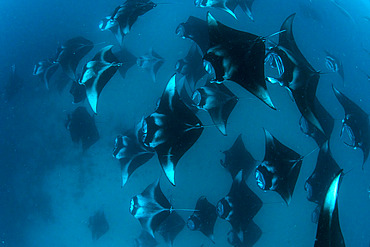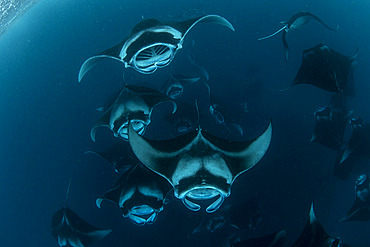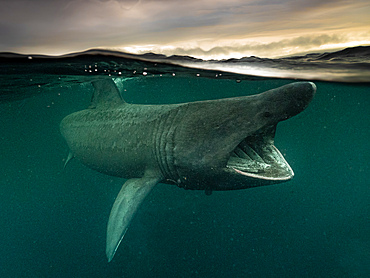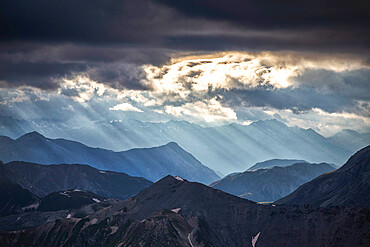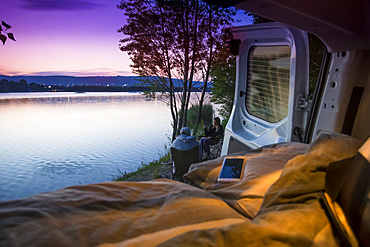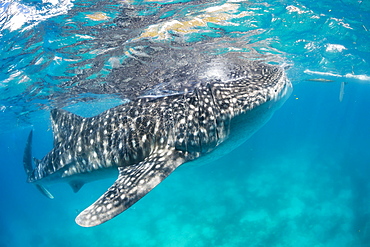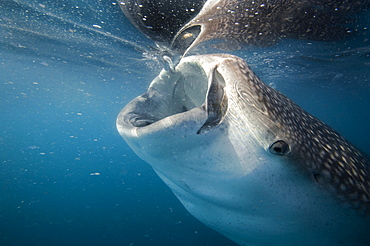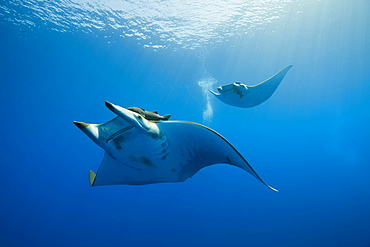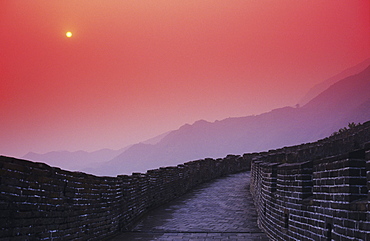Recent searches
Loading...
860-292439 - Reef manta ray (Mobula alfredi) feeding between the corals in the pools of Longoni, Mayotte.
860-292371 - Reef manta rays (Manta alfredi formerly Manta birostris) chain-feeding on plankton. Hanifaru Lagoon, Baa Atoll, Maldives, Indian Ocean
860-292370 - Reef manta rays (Manta alfredi formerly Manta birostris) chain-feeding on plankton. Hanifaru Lagoon, Baa Atoll, Maldives, Indian Ocean
1350-6535 - Split shot of a Basking Shark (Cetorinus Maximus) in Gunna Sound, Isle of Colll, Scotland. It's mouth is gaping as it feeds. Clouds are lit with the setting sun in the background.
860-291054 - Anemone (Urticinopsis antarctica). It is a filter feeder and opportunistic predator. Antarctic Peninsula, Antarctica
1269-738 - Sun rays filter between black clouds at sunset, Stelvio Mountain pass, Stelvio National Park, Valtellina, Lombardy, Italy, Europe
1116-52235 - Millennial couple kissing on Lanikai Beach with the Mokes Islands in the background; Lanikai, Oahu, Hawaii, USA
1116-52136 - Travelers pull up alongside a lake in Bratislava to free camp for the night. A view from the bed in the back of the camper van; Bratislava, Bratislava Region, Slovakia
1116-52278 - Mount Shuksan and Clouds, Washington, USA
1116-52236 - Millennial couple kissing on Lanikai Beach with the Mokes Islands in the background; Lanikai, Oahu, Hawaii, USA
1116-52234 - Millennial couple kissing on Lanikai Beach with the Mokes Islands in the background; Lanikai, Oahu, Hawaii, USA
1116-52238 - A Millennial couple walking along Lanikai Beach with Mokapu Point and the Moku Manu Islands in the background; Lanikai, Oahu, Hawaii, USA
1116-52233 - Close-up of millennial couple kissing on Lanikai Beach; Lanikai, Oahu, Hawaii, USA
1350-2430 - Manta ray, Manta birostris, feeding at night, Kailua-Kona, Big Island, Hawaii
1178-34039 - Caucasian man pouring breakfast coffee
1178-34038 - Caucasian man pouring breakfast coffee
1350-8 - Transit of Venus, June 8, 2004, from Luxor, Egypt. A single image taken near mid-transit. Taken with a Sony DSC-V1 digital camera shooting afocally through a 40mm eyepiece and on a 90mm apochromatic refractor, equatorially mounted and driven. Shot thru a Baader solar filter, which gives a white Sun. Yellow coloration added in Photoshop.
1350-28 - The Carina Nebula (aka Eta Carinae) in the southern sky, shot December 11, 2012 from Timor Cottage, Coonabarabran, NSW, Australia. This is a stack of 5 x 12 minute exposures at ISO 400 with the Canon 5D MkII (filter modified) and Astro-Physics 105mm Traveler apo refractor and 6x7 field flattener.
1350-18 - Gum Nebula area of Vela and Puppis. Taken from Atacama Lodge, Chile, March 19, 2010, with modified Canon 5D MkII and Sigma 50mm lens at f/4, for stack of 10 x 6 minute exposures (Mean combined) at ISO 800 plus 2 x 6 minutes with Kenko Softon filter. High contrast boost and Selective Colour adjustments to bring out nebulocity while retaining neutral sky.
1350-96 - The partial eclipse of the Sun, October 23, 2014, as seen from Jasper, Alberta, in this case shot through thin cloud but that makes for a more interesting photo than one in a clear sky. This is still shot through a mylar filter, on the front of a 66mm f/6 apo refractor using the Canon 60Da for 1/25 sec exposure at ISO 100. The colours are natural, with the mylar filter providing a neutral 'white light' image. With the Sun dimmed a lot by cloud, the longer exposure allowed picking up light and colours in the surrounding clouds.
1350-97 - The partial eclipse of the Sun, October 23, 2014, as seen from Jasper, Alberta, shot under clear skies through a mylar filter, on the front of a 66mm f/6 apo refractor using the Canon 60Da for 1/8000 (!) sec exposure at ISO 100. The colours are natural, with the mylar filter providing a neutral 'white light' image. The big sunspot on the Sun that day is just disappearing behind the Moon's limb. The mylar filter gave a white Sun, its natural colour, but I have tinted the Sun's disk yellow for a more pleasing view that is not just white Sun/black sky.
1350-45 - This is the central area of Cygnus and its bright Milky Way starcloud surrounded by red nebulosity. At left is the star Sadr (gamma Cygni) with the complex of nebulosity catalogued as IC 1318. At centre is the distinct Crescent Nebula, NGC 6888, a expanding nebula created by winds from a hot Wolf-Rayet star. At bottom left is the star cluster Messier 29, though looking a little lost in the rich starfields here. At top is the cluster IC 1311, looking more obvious than M29 but not observed visually and included in the NGC catalog. Odd. At far right are the large and loose star clusters NGC 6883 and NGC 6871, the latter an obvious binocular sight. To the left of Sadr is the small cluster NGC 6910. The dark nebulas B145 and LDN 862 are at right. The small emission nebula at bottom is Sharpless 2-104.
1350-58 - This is the nebula rich region in the constellation of Monoceros the Unicorn with the dark Cone Nebula (left of centre) and the small V-shaped and bright Hubble's Variable Nebula at bottom, a reflection nebula that varies in form and brightness. Above the Cone Nebula is the triangular Christmas Tree Cluster, NGC 2264, here upside down as the bright blue star 15 Mon is the base of the tree. The large region of nebulosity is Sharpless 2-273. The V-shaped dark nebula above centre is LDN 1603.
1350-98 - The partial solar eclipse of October 23, 2014 as seen from Jasper, Alberta, at a public event in Centennial Park as part of the annual Dark Sky Festival. This is a single-exposure image showing the scene near mid-eclipse with telescopes from volunteers from the Royal Astronomical Society of Canada, and the mostly clear skies above with the crescent Sun visible through the handheld polymer solar filter.
1350-17 - Nebulosity in the heart of Cygnus the Swan, including the North America Nebula and Pelican Nebula at left (NGC 7000 and IC 5070) and Gamma Cygni complex at right (IC 1318). The Crescent Nebula (NGC 6888) is at lower right. This is a stack of 5 x 4 minute exposures at f/2 with the 135mm lens and modified Canon 5D MkII at ISO 800, plus another three similar exposure images but taken thru the Kenko Softon filter for the star glows. Taken from home Sept 10, 2013.
1350-7 - Transit of Venus, June 8, 2004, from Luxor, Egypt. A composite image (layered in Photoshop) of individual multiple shots taken from just after 2nd contact to just before 3rd contact. Taken with a Sony DSC-V1 digital camera shooting afocally through a 40mm eyepiece and on a 90mm apochromatic refractor, equatorially mounted and driven. Shot thru a Baader solar filter, which gives a white Sun. Yellow coloration added in Photoshop.
1350-47 - This is the Belt of Orion with its three blue stars across the top of the frame (L to R: Alnitak, Alnilam, and Mintaka), with the iconic Horsehead Nebula (aka B33) below Alnitak, with the dark Horsehead set against the bright nebula IC 434, aka Orion's Dagger. The pinkish nebula above Alnitak is NGC 2024, the Flame Nebula. The small blue reflection nebula left of the Horsehead is NGC 2023, with smaller IC 435 to the left of it. The field is filled with the large open cluster Collinder 70. The multiple star at bottom left of centre is Sigma Orionis. Many other smaller bits of reflection nebulas populate the field in and around the Belt.
1350-123 - NGC 7000, the North America Nebula, with the Pelican Nebula, IC 5067, at right, in Cygnus, taken from home November 21, 2016 as part of testing of the Explore Scientific FCD100 102mm apo refractor. This is a stack of 5 x 6-minute exposures at f/7 with the ES field flattener, and at ISO 1600 with the filter-modified Canon 5D MkII. Star diffraction spikes added with AstronomyTools actions.
1112-5677 - Young whale shark (Rhincodon typus), filter feeding near snorkeler at El Mogote, Baja California Sur, Mexico, North America
1112-5674 - Young whale shark (Rhincodon typus), filter feeding near the surface at El Mogote, Baja California Sur, Mexico, North America
1112-5675 - Young whale shark (Rhincodon typus), filter feeding near the surface at El Mogote, Baja California Sur, Mexico, North America
1112-5676 - Young whale shark (Rhincodon typus), filter feeding near snorkeler at El Mogote, Baja California Sur, Mexico, North America
1116-48183 - A young mom and her daughter playing on a saucer swing in a playground on a warm autumn evening, Edmonton, Alberta, Canada
1116-47439 - Two sisters hugging each other in a city park on a warm autumn day: Edmonton, Alberta, Canada
1116-48192 - A beautiful mom and her two little daughers walking their Great Dane through the woods in a city park on a warm fall evening, Edmonton, Alberta, Canada
1116-47440 - Two sisters hugging each other in a city park on a warm autumn day: Edmonton, Alberta, Canada
1116-48184 - A young mom and her daughter playing on a saucer swing in a playground on a warm autumn evening, Edmonton, Alberta, Canada
1116-47692 - Heavily blurred street scene, Toronto, Ontario, Canada
1116-48262 - Toddler Making Funny Faces At The Camera And Putting His Fingers in His Mouth, Langley, British Columbia, Canada
1116-47895 - A young mother taking a self-portrait with her kids in a park with the image having a vintage effect applied, Edmonton, Alberta, Canada
1116-48179 - A young girl posing for the camera while standing on a bouncing balance beam in a playground on a warm autumn evening at sunset, Edmonton, Alberta, Canada
1116-47746 - Young Girl Trying To Drill A Hole In The Ice Of Frozen Lake Wabamun Without Any Success: Wabamun, Alberta, Canada
1116-48015 - Four female golfers posing for a social media portrait on a golf course with a vintage style filter applied to the image, Edmonton, Alberta, Canada
1116-47691 - Heavily blurred street scene, Toronto, Ontario, Canada
1269-620 - Sun rays filter between fog in autumn, Soglio, Bregaglia valley, Graubunden, Switzerland, Europe
1116-46886 - Young couple taking self-portraits with a cell phone while standing up in their sunroof of their vehicle, Edmonton, Alberta, Canada
1116-46887 - A young woman with long blond hair twirls and runs freely in a grass field in a park at sunset, Edmonton, Alberta, Canada
1116-46871 - Young couple standing at the back of their packed vehicle with back door open and the young man in using his cell phone while the young woman waits impatiently, Edmonton, Alberta, Canada
1116-46740 - A Young Couple Embracing Each Other And Looking Into Each Other's Eyes On A Bridge In A City Park In Autumn, Edmonton, Alberta, Canada
1116-46742 - A Young Couple Holding Each Other Closely And Kissing In A City Park In Autumn, Edmonton, Alberta, Canada
1116-46739 - A Young Couple Running On A Bridge In A City Park In Autumn, Edmonton, Alberta, Canada
860-288602 - Great Flamingo (Phoenicopterus roseus) in water Camargue, France
1116-44816 - Young Woman With Long Hair Listening To Music Outdoors On Her Smart Phone In A City Park In Autumn, Edmonton, Alberta, Canada
1116-44659 - A Young Asian Couple Kissing In A Park In Autumn And Making A Heart With Their Hands In The Warmth Of The Setting Sun, Edmonton, Alberta, Canada
1116-44722 - Two Sisters Having Fun Outdoors And Singing Together In A City Park While Listening To Music On An Mp-3 Player, Edmonton, Alberta, Canada
1116-44660 - A Young Asian Couple Holding Hands While Walking Through A Park In Autumn And Enjoying The Warmth Of The Sunlight During The Early Evening, Edmonton, Alberta, Canada
1116-42098 - Blurred scene of Bloor Street in Toronto, Toronto, Ontario, Canada
1269-278 - Sun rays filter between stormy clouds during sunset with Sassolungo group in the foreground, Fassa Valley, Trentino, Dolomites, Italy, Europe
1116-39965 - A Whale Shark (Rhiniodon typus) with it's mouth open, filter feeding at the surface. This is the world's largest species of fish, Oslob, Philippines
1116-39728 - Detail of the center branching arms of a Crinoid or Feather Star (Lamprometra klunzingeri) open and feeding on plankton at night, Philippines
1116-39729 - Both a Crinoid Commensal Shrimp (Periclimenes cornutus) and a Crinoid Squat Lobster (Allogalathea elegans) on a crinoid. These tiny crustaceans are commensal on crinoids or feather stars and take their color from the host, Philippines
1116-39937 - Reef Manta Rays (Manta alfredi), feed over baskets of lights used to attract plankton off the Kona Coast, Kona, Island of Hawaii, Hawaii, United States of America
1179-3453 - Man at sunset with graduated photography filters in his hand, San Marco Pass, Orobie Alps, Bergamo province, Lombardy, Italy, Europe
1116-39589 - Young couple in a park posing for a self-portrait with their cell phone at sunset; Edmonton, Alberta, Canada
1172-3259 - Shirataniunsuikyo, Yakushima, Kagoshima, Japan
1112-3190 - Whale shark (Rhincodon typus), filter feeding underwater off El Mogote, near La Paz, Baja California Sur, Mexico, North America
1112-3188 - Whale shark (Rhincodon typus), filter feeding underwater off El Mogote, near La Paz, Baja California Sur, Mexico, North America
1112-3186 - Whale shark (Rhincodon typus,) filter feeding underwater off El Mogote, near La Paz, Baja California Sur, Mexico, North America
860-285221 - Humpback whale feeding on the surface, Sea of ??Cortez
860-285205 - Whale Shark sifting plankton at surface-Gulf of California
860-285201 - Mouth of a Whale Shark sifting plankton, Gulf of California
860-285222 - Humpback whale feeding on the surface, Sea of ??Cortez
860-285223 - Humpback whale feeding on the surface, Sea of ??Cortez
860-285204 - Whale Shark sifting plankton with Remora -Gulf of California
860-285203 - Mouth of a Whale Shark sifting plankton, Gulf of California
1167-119 - Moose (Alces alces) cow in pond breaks from filter feeding and stares at camera, Grand Teton National Park, Wyoming, United States of America, North America
832-307611 - Sign, particulate filer, For the sake of the environment, this vehicle is equipped with a particle filter
832-244095 - Aerial picture, Waterworks Essen, water filter, Ruhr, Ueberruhr with Ueberruhr-Island, Essen, Ruhr area, North Rhine-Westphalia, Germany, Europe
1161-3671 - Chef prepares Peking duck in Quanjude Roast Duck restaurant, Wangfujing Street, Beijing, China
832-70882 - Tea being poured, tea room, Muzaffaragarh, Punjab, Pakistan, Asia
1113-35580 - Aerial view of a fossil-fuel power station with cooling towers, Buschhaus Power station, Helmstedt, Lower Saxony, northern Germany
1113-22835 - Sicklefin Mobula, Mobula tarapacana, Azores, Princess Alice Bank, Atlantic Ocean, Portugal
1113-22838 - Sicklefin Mobula, Mobula tarapacana, Azores, Princess Alice Bank, Atlantic Ocean, Portugal
1113-22836 - Sicklefin Mobulas, Mobula tarapacana, Azores, Princess Alice Bank, Atlantic Ocean, Portugal
1116-30642 - Hawaii, Maui, Kapalua Beach, Purple sunset over ocean.
1116-37873 - Hawaii, Big Island, Kona, manta ray feeds (Manta birostris) front view A86C
1116-37936 - Oregon, Eugene, Spencer Butte Park sunlight filters through fog, trees in forest A24E
1116-34304 - China, Mu Tian Yu, The Great Wall of China, bright red sky and distant moon
1116-30871 - Oregon, Portland, Wildwood Trail, Warm sunlight shining through fir trees, ferns and ivy.
1116-30632 - Hawaii, Big Island, Pu'uhonua O Honaunau (Place of Refuge), Palms and heiau silhouetted against sunset.
1116-33758 - Nepal, Kathmandu Valley, overhead view of hill tops silhouetted among yellow haze and sky.
1116-30650 - Hawaii, Maui, Hana, View of Alau Island from Hana shore at sunrise.

